Napoli have so far this season blown teams away with ease in both the Serie A and the UEFA Champions League, where they sit at the top of both coming into the new year. While the praise of their excellent open-play football is rightly justified, it can be easy to forget just how important set pieces have been for them this season. In the 21 games played out in this campaign, Napoli have needed to score goals from corners on four occasions to put them into the lead, whilst also scoring another three equalisers from corners. A goal to put you in the lead can be valued at 2 points, whilst an equaliser at 1, so Napoli have gained 11 points through set-pieces in both the Serie A and Champions League together.
Gli Azzurri have scored 11 goals from corners this season, and the stats from their league campaign have been more impressive than anyone else’s in the league. From 88 corners this season, they have managed 6.29 xG, and attempted a shot from 55% of those corners. They have created more xG than anyone else in the league, while only Juventus have managed to get a higher percentage of shots off from their corners, meaning that Napoli’s corners are the second most accurate in the league. Only Inter Milan have managed a better xG per shot attempted from corners than Napoli as well.
In this tactical analysis, we will delve into the tactics Luciano Spalletti has used to make Napoli so dangerous from corners. The set-piece analysis will show the different ways that Napoli have been able to make the first contact with so many corners. Furthermore, the analysis will look into the movement and routines used, and why this may be the difference between them winning the Scudetto or not.
Sneaking in at the near post
In this first corner routine, Napoli attempt to make the first contact at the front of the six-yard box, to redirect the ball across the goal, rather than scoring from the first contact. Deliveries into this target area are more likely to be won by the attacking team, as the defensive team will usually throw most of their players in between the two posts where contact is much more likely to result in a goal. Napoli make smart movements to exploit the open area in front of the six-yard box.
Hellas Verona set up in a man-marking system defensively, with three zonal defenders. Each of the three players are between the front post and the front edge of the six-yard box, precisely the area which Napoli want to target.
In instances where the target area is harder to access, Napoli utilise decoy runs to create space. As shown in the image below, Rrahmani (starts at the front post), makes a move towards the zonal defenders, in their blindside, as the corner taker begins his run-up. This movement attracts the attention of the central of the three zonal markers (#22). That zonal marker now has two problems to deal with: 1) an unmarked attacker six yards from goal behind him, and 2) there is an open area in front of him, which he needs to be able to get across to.
As the decoy run is made, the defender can be seen turning his head, giving himself an updated image of what is going on around him. While the defender is no longer looking at the ball, Di Lorenzo attacks the open space on the front edge of the six-yard box. Attacking the open space while his defender is distracted gives him that yard of space he needs to comfortably get to the cross first. The timing of the decoy run needs to be perfect so that by the time the defender looks at the ball again, it is already in motion and impossible to reach.
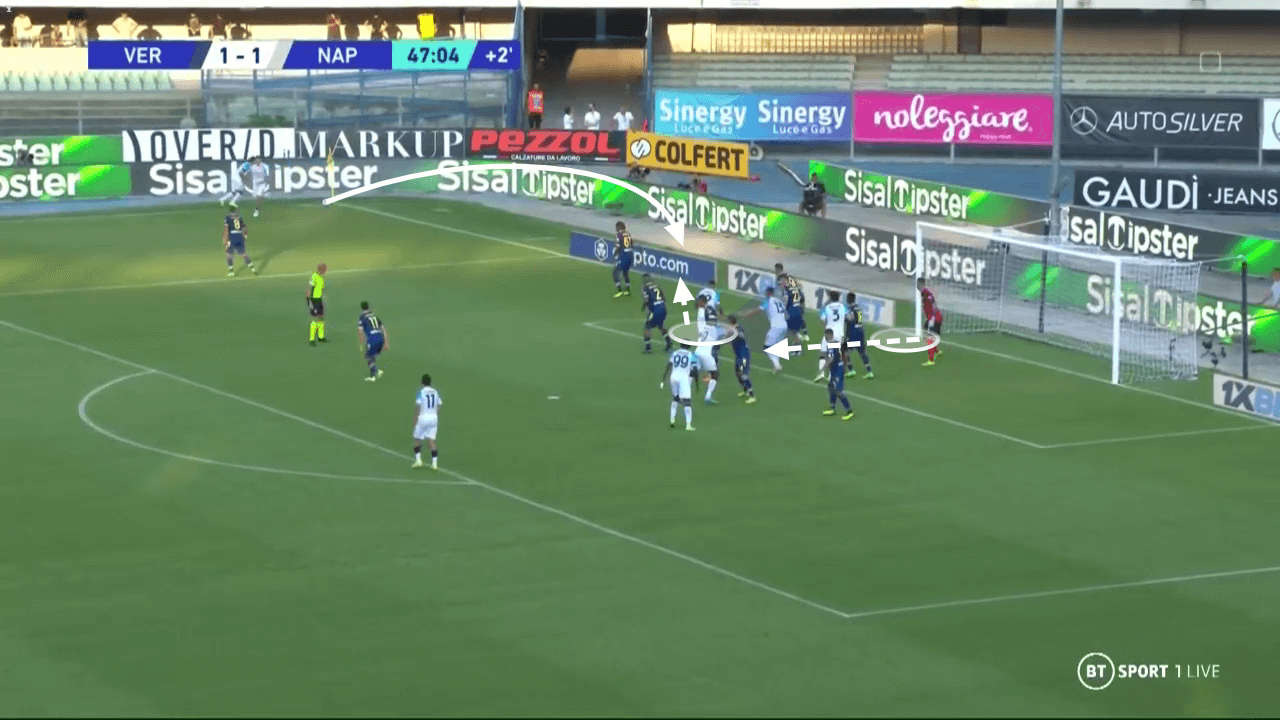
The above images showed the first phase of these kinds of corners. In ‘underhit’ crosses, there are two phases. The first of which is to make the first contact inside the eighteen-yard box. In this phase, the angle to the goal makes it extremely difficult to score a header, but that is not the aim. The first phase of an ‘underhit’ cross is simply designed to lure defenders in, while attackers can make premeditated movements to the actual target area.
There are three main benefits to creating chances in this method. The first is that a redirected header from six yards becomes extremely difficult to defend against. Imagine a cross being played in from the by-line in the same position as the header is played from in the image below. Defenders have no clue whether the cross will go to the back post or the front post, and they don’t know if it will be played hard and low, or perhaps be lofted across the goal. The unpredictability, along with the proximity of such a delivery providing no reaction time makes the defenders powerless in these scenarios. They have no time to move positions, and hardly any time to react to deal with the ball being played across. A defender can try to predict where the ball will go, but a wrong move can create an unopposed path to goal for the attacker.
Bringing it back to the flick-on from a corner, chaos is caused, as defenders don’t know if that header is about to be flicked towards the back post or perhaps redirected towards goal. The header to the back post can be looped high or arrowed low to the back post. Defenders have no knowledge of how the ball will move, and with the header being played six yards from goal, it’s impossible to react, and there may as well be statues inside that six-yard box.
A second advantage of the ‘underhit cross’ is that goalkeeper cannot come out to claim the cross. When a delivery goes further towards the middle of the goal or has a higher trajectory, it becomes easier for goalkeepers to come and catch the ball. The flat and low delivery is impossible for goalkeepers to reach, and so the possibility of a goalkeeper intercepting the cross is eliminated.
Another benefit of a flick-on is that it attracts attention from the defending team. As the ball is crossed towards the near post, every defender naturally moves towards the ball. This creates an abundance of space at the back post, where defenders move away, to try and get closer to the ball at the near post. The second phase of this corner comes into action at this point, where we can see Victor Osimhen below making a move towards the back post whilst everyone’s eyes are glued to the ball. Osimhen is behind his marker and the defender has no idea that he has moved into a deadly shooting position. He can then attack the open space where the ball is flicked towards and score an easy tap-in after a well-thought-out routine.
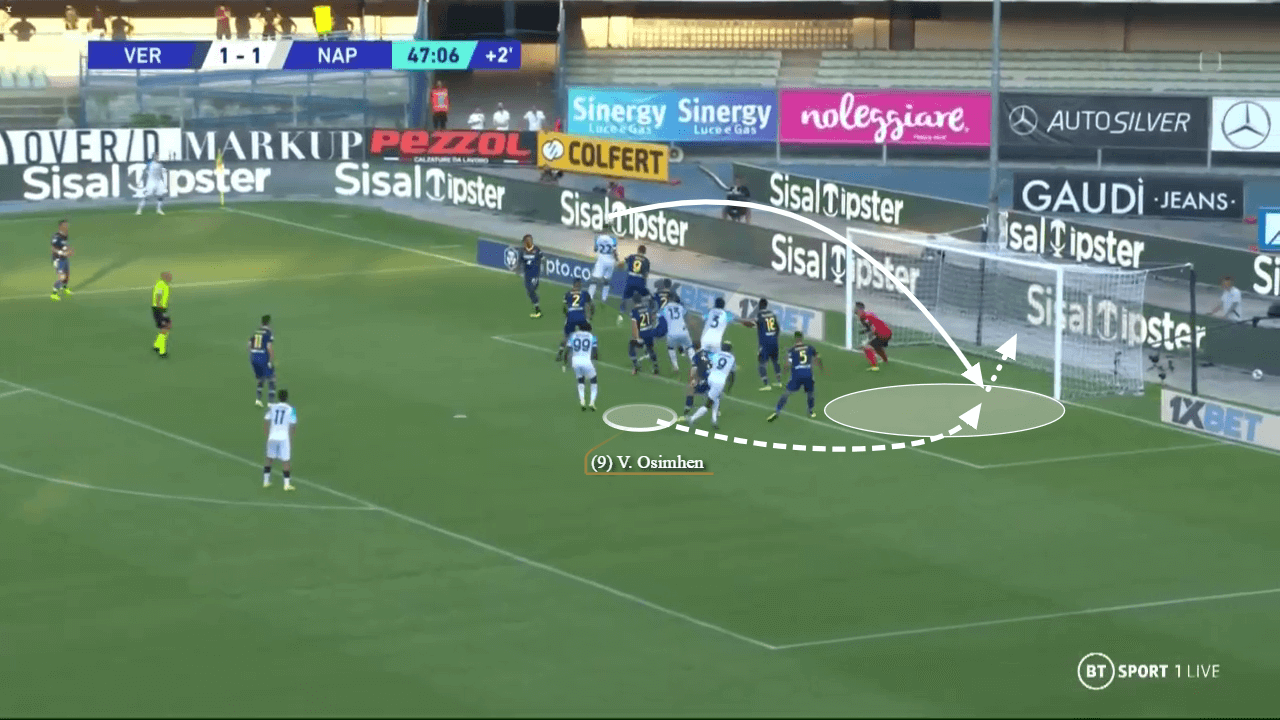
Efforts from deep
Napoli have been smart to adapt their deliveries depending on how the opposing team sets up to defend. In the image below, we can see Lazio heavily set up in a zonal style, with eight players inside the six-yard box. During these scenarios, it is nearly impossible to deliver the ball inside the six-yard box, due to the heavy traffic inside the area. Gli Azzurri have shown their understanding of both man marking and zonal marking styles, knowing where to take advantage of the differing styles.
A common weakness of zonal markers is their static position during the delivery, meaning that it is difficult to get the jumping reach of someone who is in motion. Napoli take advantage of that in the image below, where Osimhen has no one marking him and can attack a cross with a six-yard run-up. The ball is delivered towards the edge of the six-yard box, and the fact that Osimhen can attack the cross allows him to outjump the Lazio defender, and get to the header first, although the attempt ends up going off target.
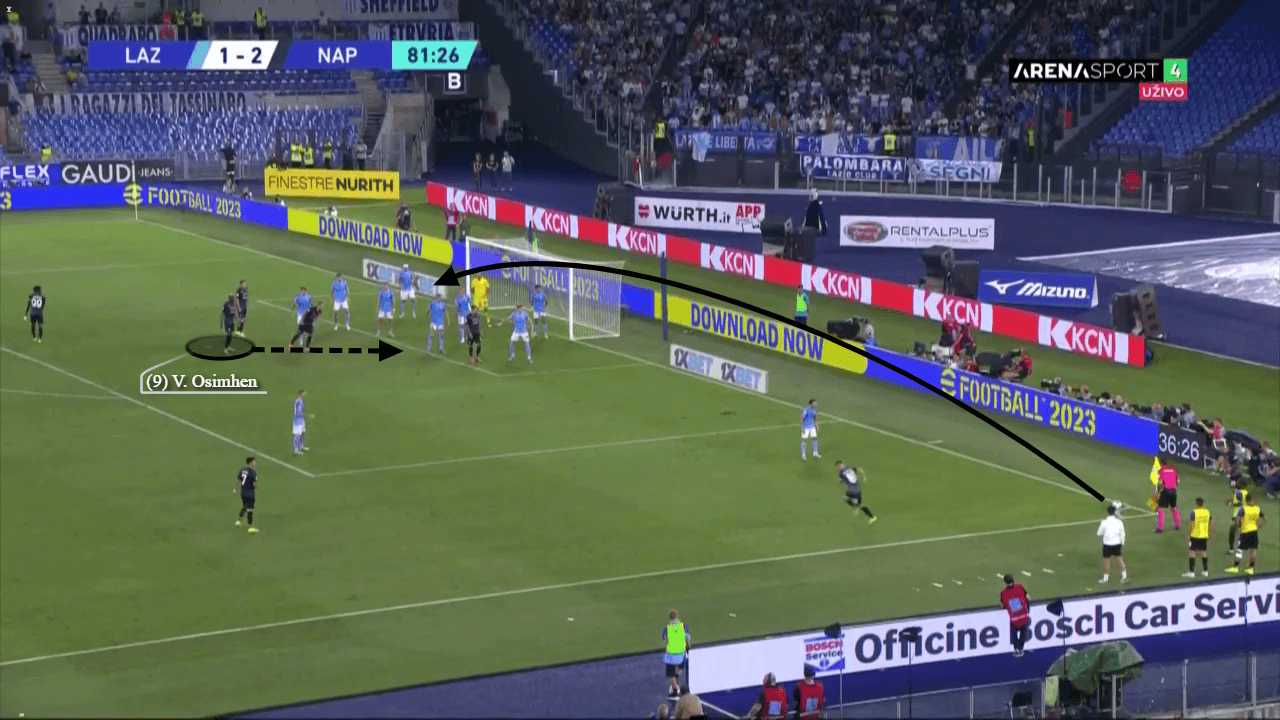
An alternate method of creating chances in deeper areas is through the use of screens. As we mentioned before, Napoli have shown the knowledge and adaptability to adjust to different defending styles. Against Ajax in the UEFA Champions League group stage, we can see Ajax setting up in a man-marking style, pairing everyone up 1v1. Napoli have shown that they can expose this sort of defensive style through the use of screens or blocks.
A screen means that a teammate disturbs the movement of a man marker, which is a selfless act. The image below shows that in action, where Rrahmani runs around the front of two of his teammates, who have no intention of getting to the cross as they walk towards the goal. The two Napoli players, alongside their respective markers, set up a roadblock inside the penalty box, making it extremely difficult for Calvin Bassey to stay tight to his assigned attacker.
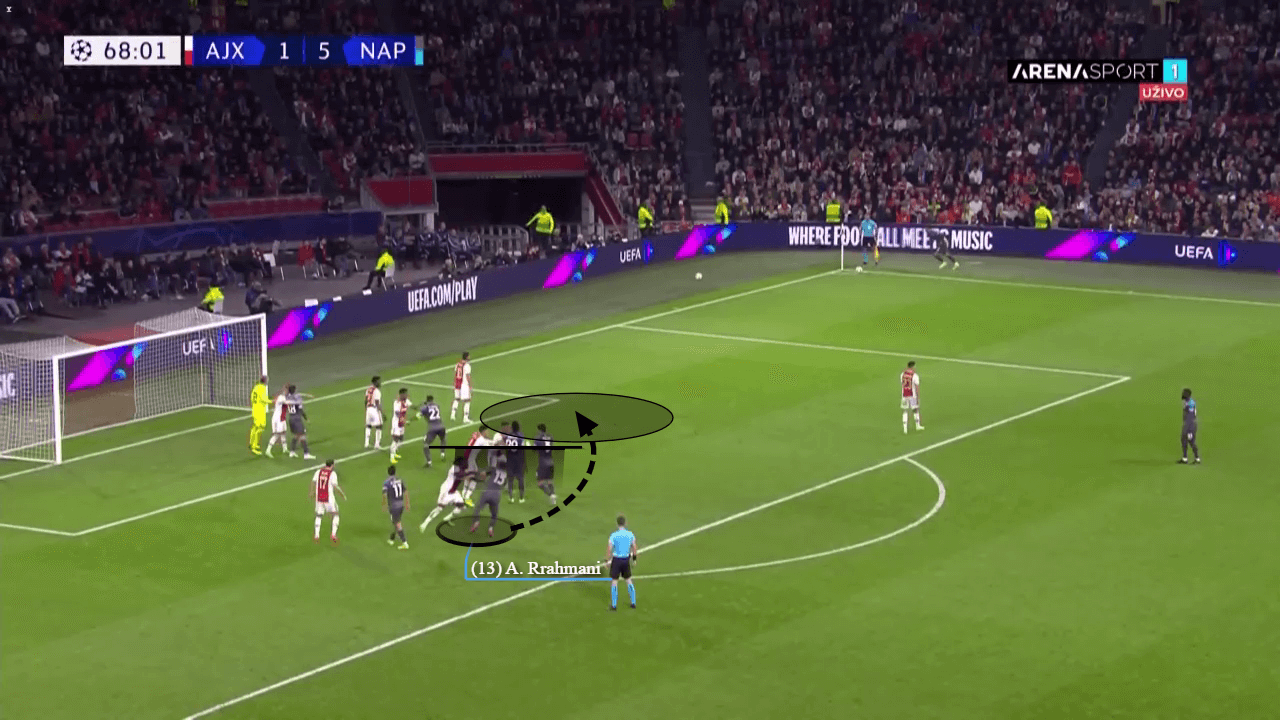
As a result, Rrahmani can be seen in the picture below attempting a volley, whilst his man marker is caught on the wrong side, due to him having to get around the roadblock. The only way to get to the open area was to follow his marker, but obviously you don’t want to be behind an attacker when they about to take a shot, as it is impossible to get to the ball ahead of them in that case.
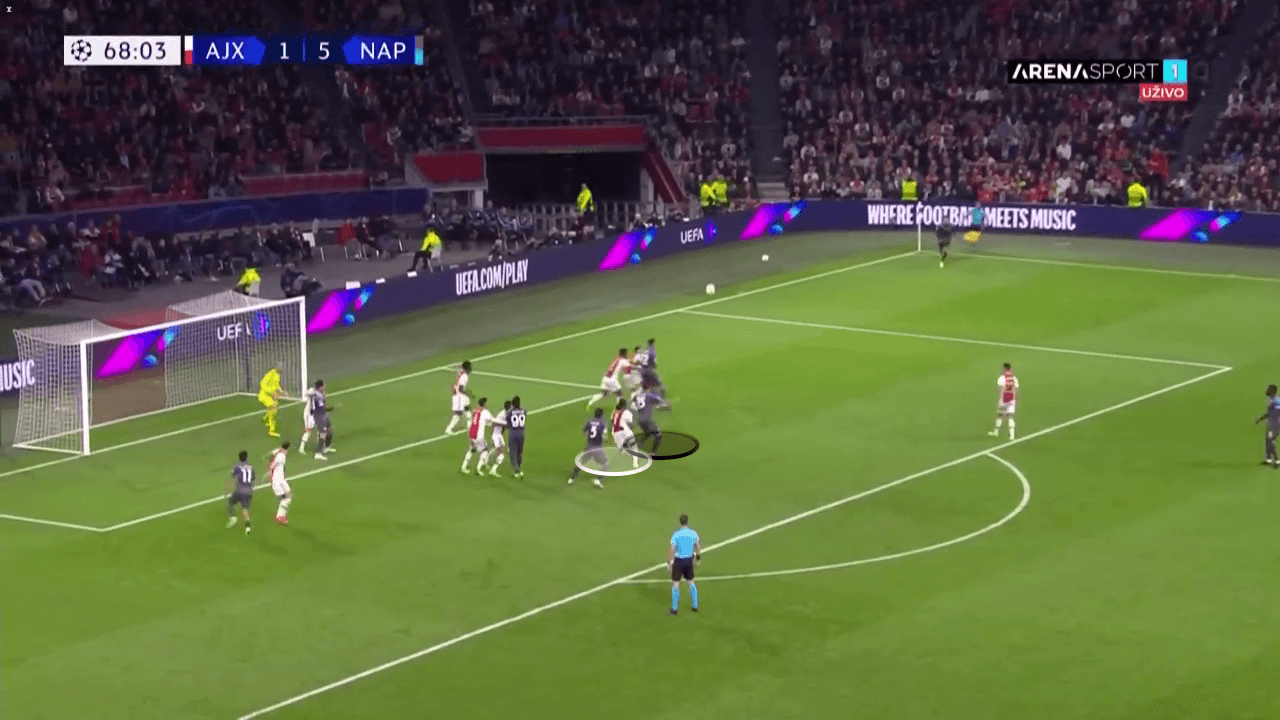
Targeting the back post
Like with the ‘underhit’ crosses, Napoli have attempted to target the area at the back post through decoy runs. In the earlier scenarios, the cross did indeed arrive at the near post originally, but in order to remain unpredictable, and perhaps due to the defender standing directly in front of the corner taker, Napoli have at times gone towards the back post directly. The defender standing in front of the ball prevents a flat low cross from easily reaching the front of the six-yard box, so the cross has to have a higher trajectory.
In these instances, Napoli have used a large number of decoy runs in order to create that space at the back post. The image below shows four different Napoli players all sprinting towards the front post. Against this man-marking system, it means that every defender has followed their runner to the front post. While every defender is dragged to the back post, Min-jae Kim attacks the back post.
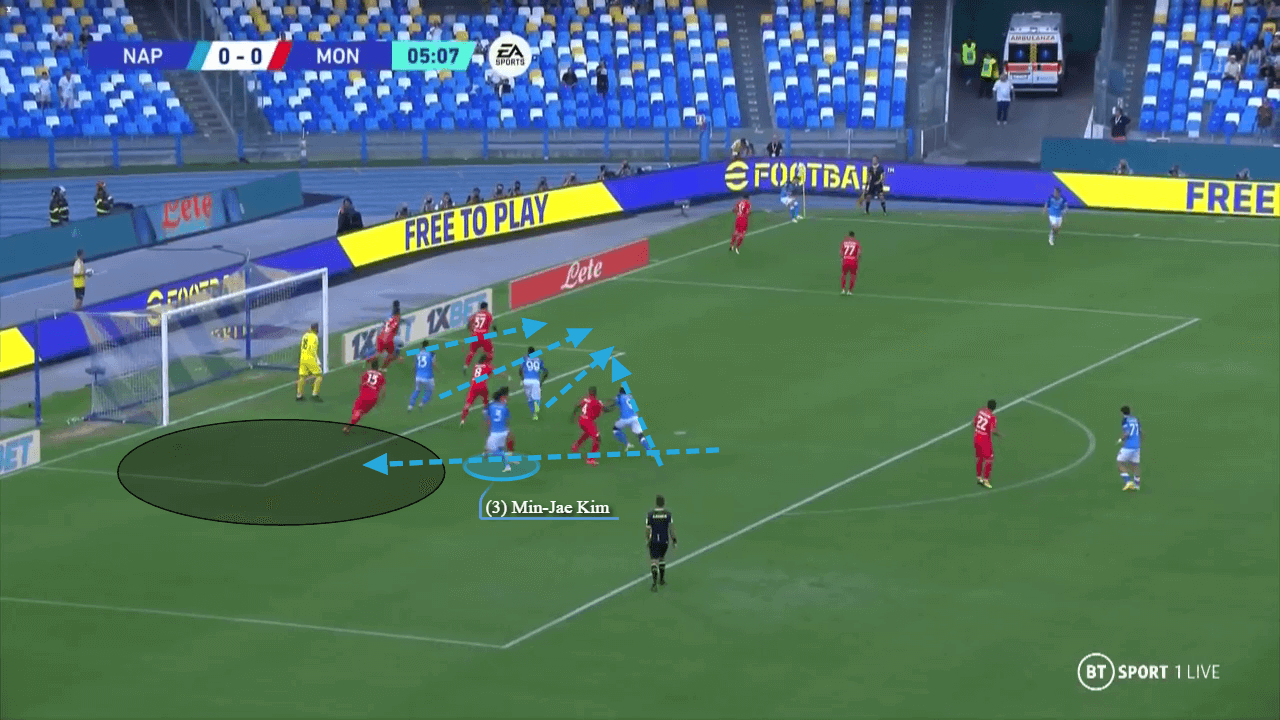
We can see in the image below, Kim is left in a 1v1 aerial duel at the back post. Because the run is organised, Kim can get to the target area before his marker, so he can jump early, rooting his defender to the ground. The early jump allows Kim to shadow his defender and allows him to easily win that aerial duel.
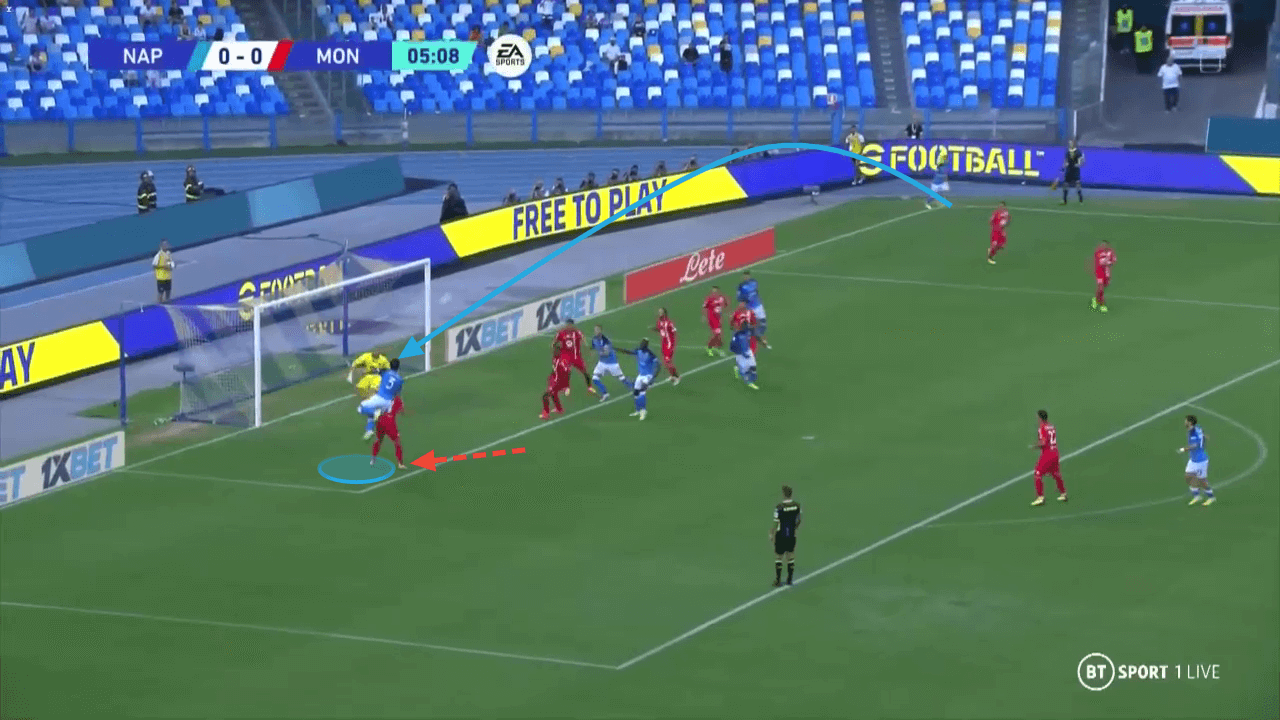
Napoli’s creativity means that no player is frequently a target as that would make it predictable and easier to defend against. Having said that, we can see below that when a player like Kim does get the cross aimed towards them, they arrive in great goalscoring situations. Kim has won three headers this season, from which he has had 0.23 xG per shot. This is a very high value for a shot, meaning that Kim has had three good goalscoring opportunities, and shows that when Napoli create a chance, it won’t be a difficult one to finish.
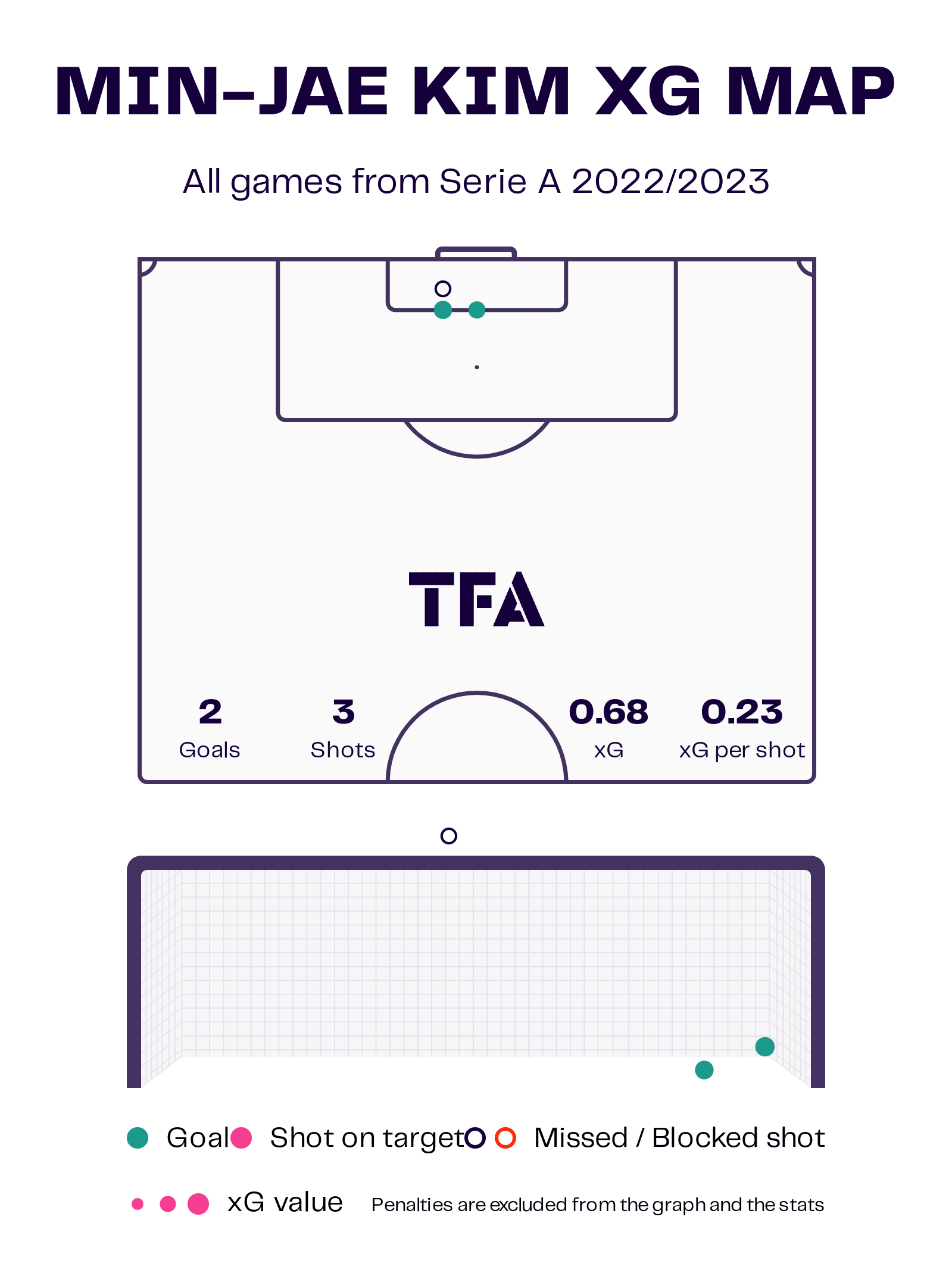
Short Corner Routines
Napoli have also shown their expertise in creating chances from short corners, perhaps on occasions where teams have thrown their entire team inside their own box. In such scenarios, there is a lot of space created outside the box where chances can be created from an even more dangerous position. The image below shows how much space is left open on the edge of the box, which Napoli aim to take advantage of.
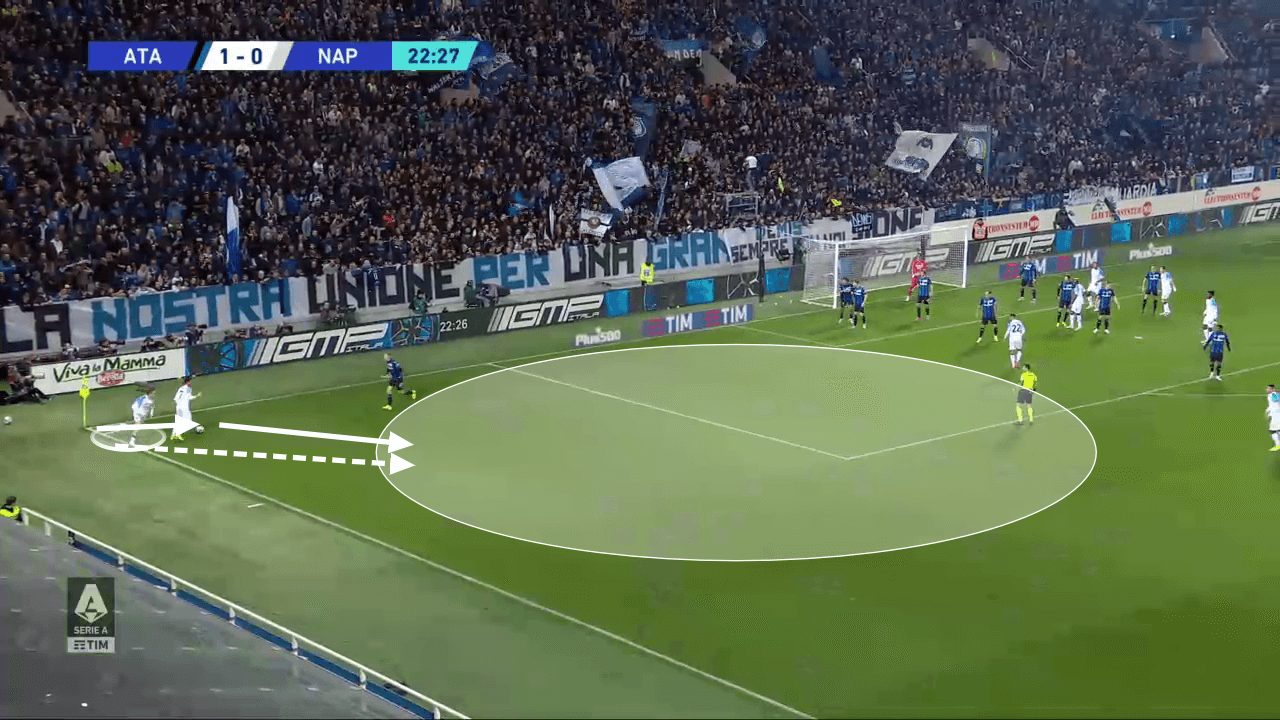
After playing a one-two, Zielinski arrives at the corner of the box, from where he can make a dangerous inswinging delivery towards the back post. An inswinging cross from the half-space can be one of the most deadly methods of chance creation, where goalkeepers are unsure whether they can come out, and even if a cross is missed by the attackers, it can still curl into the goal. From this scenario, Osimhen rises above every defender, and can easily redirect the ball into the back of the net from five yards or so.
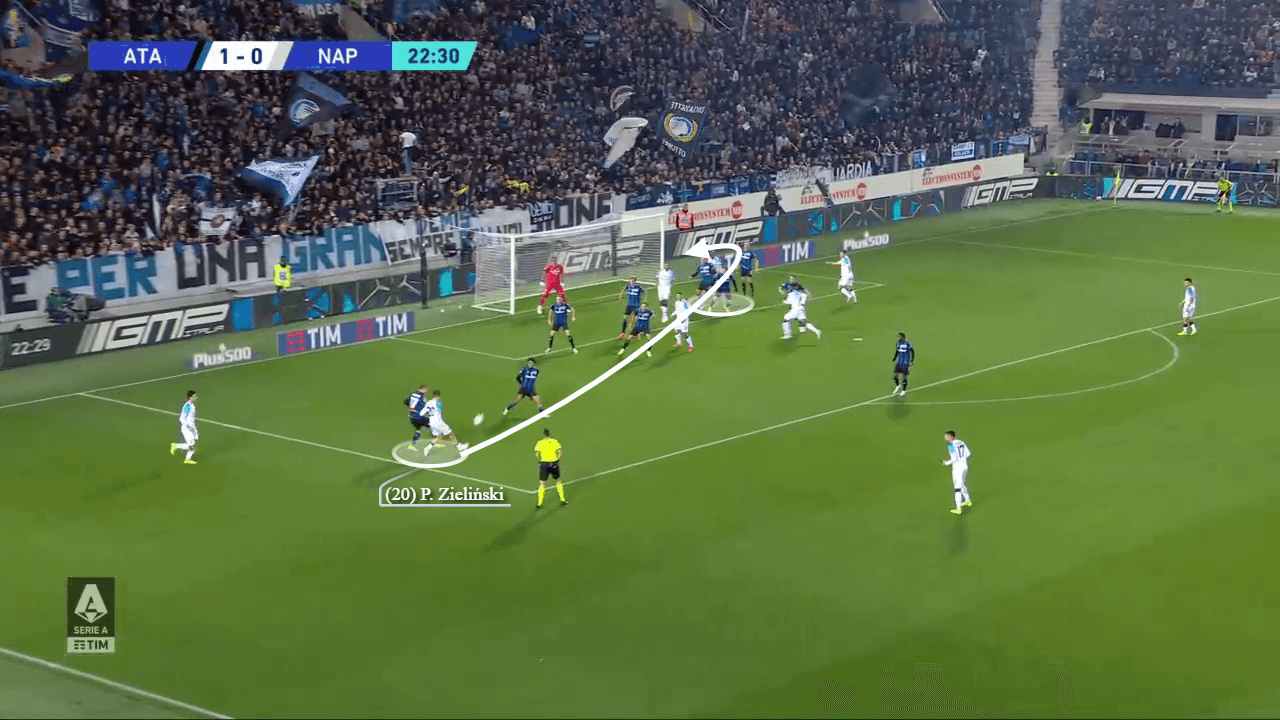
One final way in which short corners can be effective is through their ability to move an entire defensive block. As a corner is taken, there are times when it is hard to find a space to cross the ball into. Taking a short corner allows the defensive line to move away from the goal, creating space in the corridor of uncertainty, between the defensive line and the goalkeeper.
In the example below, Napoli are purposefully being very patient after taking the short corner to allow the defensive line of the opposition to move away from the goal. When the line has stepped up, Napoli then speed play up again to take advantage of the space created, and a Napoli attacker can easily attack the open space and redirect the ball into the back of the net from six yards away.
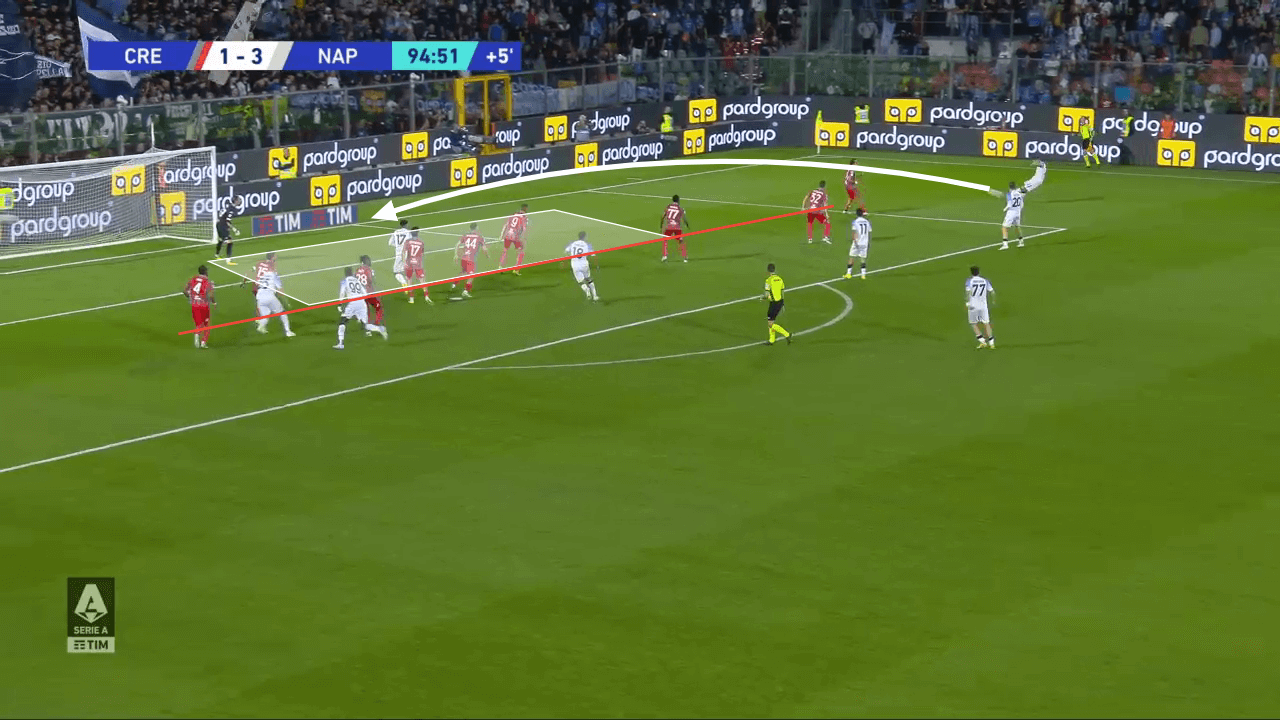
Summary
This set-piece analysis has displayed the numerous ways in which Napoli have created and scored chances from corners. Their ability to set up for corners depending on the opposition’s defending style, due to the well-informed preparation, allows them to be ready for any scenario, and have an effective way of scoring from any corner they have.
Their use of corners has gone under the radar this season, but it will continue to be crucial to their ability to gain those important points as they attempt to win the Scudetto.






Comments